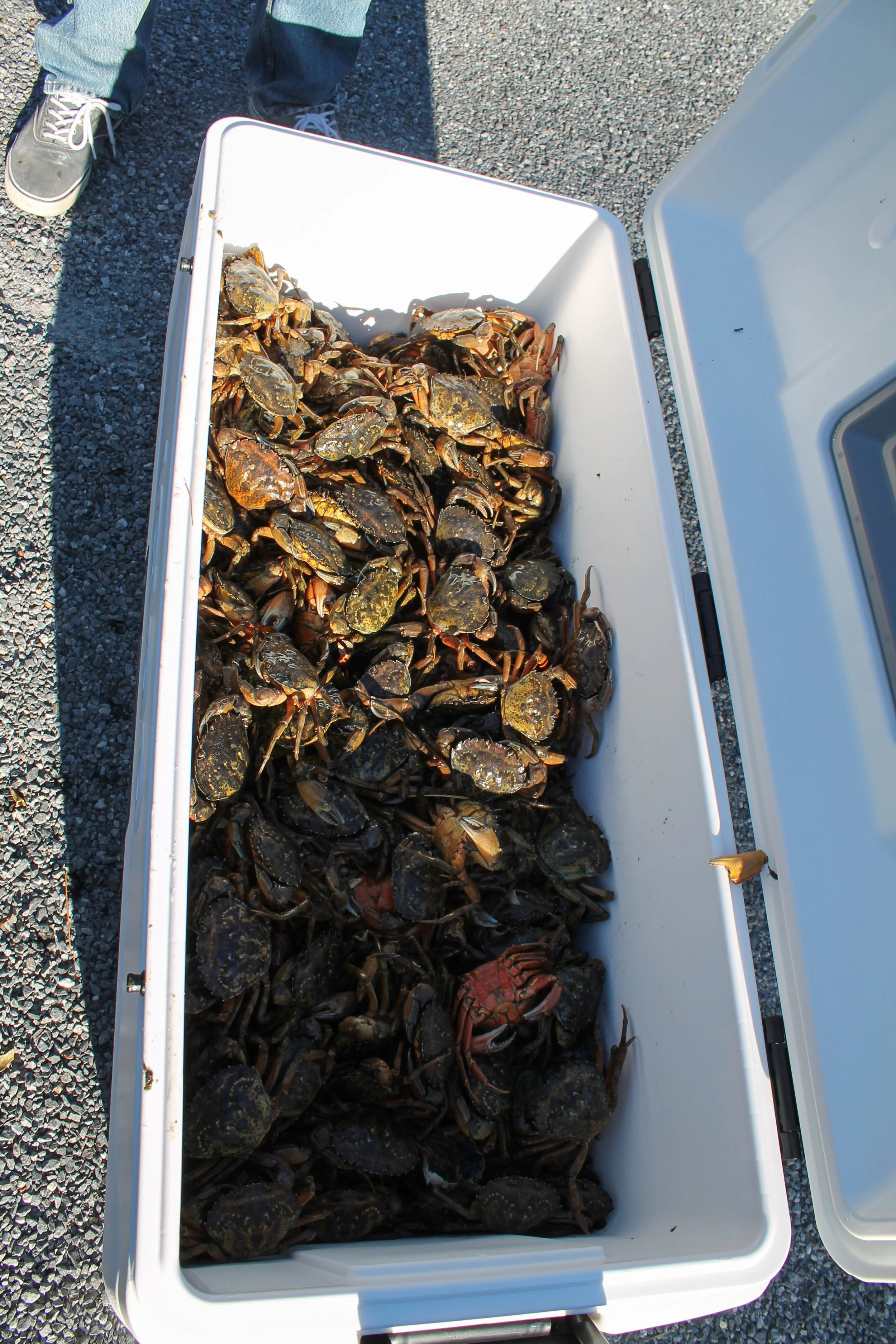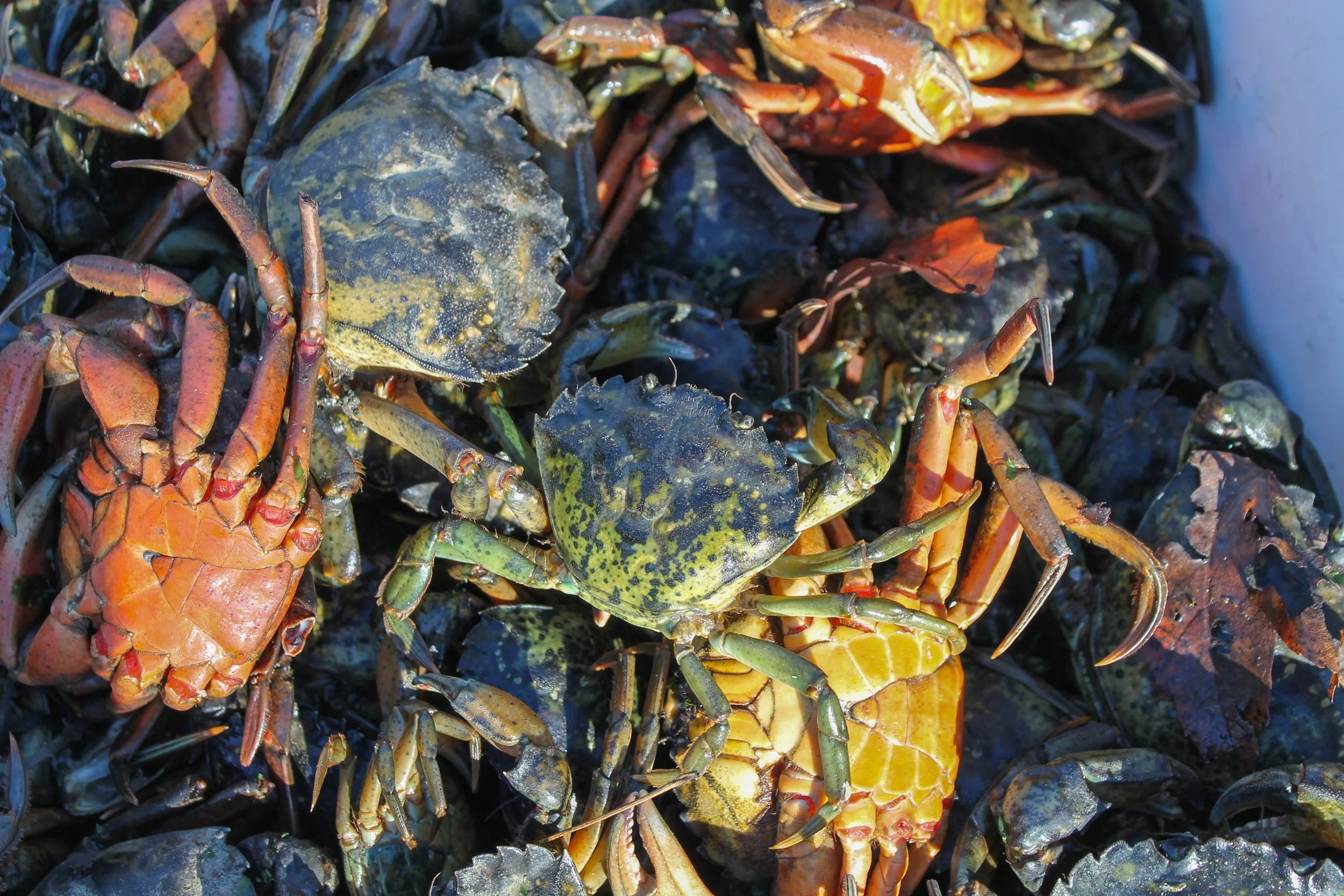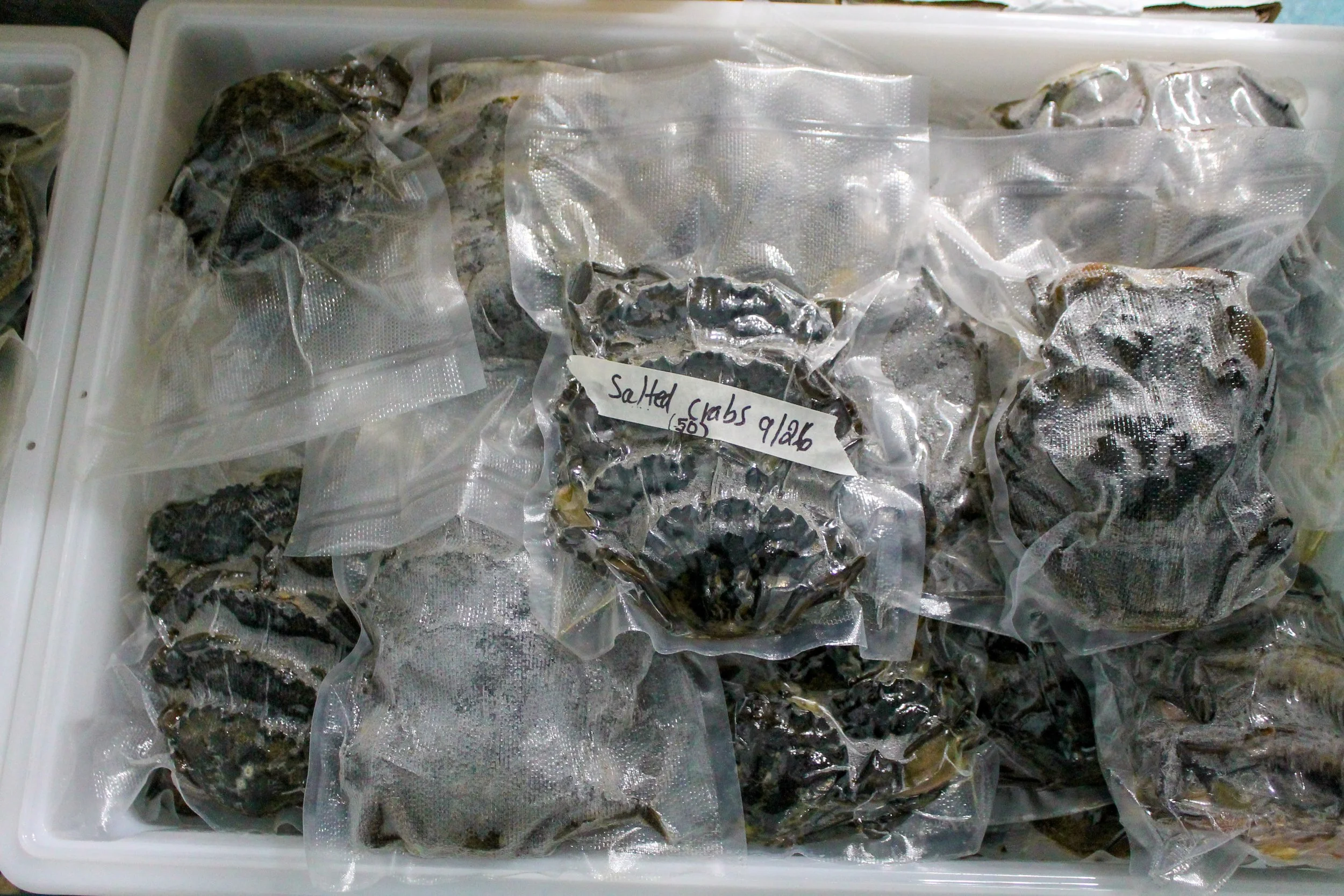Mitigation Meets Fermentation: Khmer Maine’s Kdam Prai Project Utilizes Invasive Green Crab
Written in Collaboration with Khmer Maine and Quahog Bay Conservancy
GreenCrab.org is excited to kick off a new collaboration Khmer Maine through the USDA Business Builder Program: developing kdam prai (salted crab) made from invasive green crabs removed by Quahog Bay Conservancy. Kdam prai is a fermented Cambodian condiment, traditionally made with rice paddy crabs that can be found across Southeast Asia. However, New England Khmer community members have been using green crabs to create kdam prai since the early 2000s. This program also marks an exciting new chapter in green crab processing: pairing targeted mitigation efforts with product development.
Khmer Maine’s Bunly Uy (upper left) and Marpheen Chann (upper right) pick up crabs from Quahog Bay Conservancy’s Pete Valente (plaid shirt) and Alec Bollinger (green hoodie) and Westport Island Shellfish’s Neil Stanton (lower left) and Jesse Roche (lower right)
Green Crabs in Quahog Bay (Harpswell, ME)
Green crabs pose a major threat to fisheries and ecosystems in Quahog Bay. First introduced in the early 1900s, their populations grew and started slowly taking over the intertidal. Once teeming with soft-shell clams, this region began to feel the impacts of green crab predation. A single green crab can eat up to 40 half-inch soft-shell clams in a single day but the crustacean also consumes wild and farmed oysters, quahogs, and mussels while simultaneously contributing to eelgrass decline. Poor water quality and coastal development also led to a decade-long shellfish area closure and soon “Quahog Bay” was no longer synonymous with the industry that once defined it.
Quahog Bay Conservancy (QBC) was founded in 2015 in response to the declining health of Quahog Bay in Harpswell, Maine. QBC began by conducting water quality testing, removing marine debris, and replacing outdated septic systems that discharged directly into the bay. With support from a Maine state grant, they launched a free septic pump-out service for transient boaters, helping prevent further pollution. Thanks to these combined efforts, Quahog Bay was reopened for clamming after being closed for 30 years due to poor water quality. Building on that success, QBC launched an oyster farming initiative, recognizing oysters’ natural ability to filter excess nutrients and algae from the water. Proceeds from the organization’s oyster farming are now reinvested in their conservation efforts. However, after learning about the growing impact of invasive green crabs, the conservancy decided to start trapping green crabs and purchased 100 crab traps in the summer of 2015.
Within the first year of trapping, Quahog Bay Conservancy landed 10,000 lbs of green crabs: focusing on shallow coves in the intertidal. The organization began donating green crabs to Brooks Feed and Farm and then began a partnership with Wolfe’s Neck Farm in 2019. Green crabs provide valuable nutrients such as nitrogen, phosphorus, and calcium, which enhance compost quality. However, using whole crabs proved inefficient, as they broke down slowly in compost piles. To address this, QBC acquired an industrial pulverizer through a generous donation designed specifically to crush green crabs before delivery. This equipment allowed QBC to pre-crush crabs, package them in 55-gallon barrels, and deliver them directly to compost facilities. The crushed crabs were then mixed and turned into compost more efficiently, improving the overall process and nutrient distribution.
Quahog Bay’s Industrial Pulverizer
Freshly Harvested Green Crabs
A decade later, the conservancy is now exploring culinary utilization of green crabs, partnering with nonprofit Khmer Maine to develop green crab kdam prai (salted crab).
“I believe that increasing the demand for the use of green crabs will strengthen mitigation efforts along the coast. I’m excited to contribute to this movement and help create the demand needed to make a lasting impact. If we can demonstrate practical and valuable applications for green crabs beyond composting, I would feel a sense of accomplishment — knowing we are making meaningful progress toward a shared goal of restoration and sustainability on multiple fronts.”
- Tait Nygaard, Ecology Specialist/Coordinator, Quahog Bay Conservancy
Green Crabs Harvested in Quahog Bay
Mitigation Meets Fermentation
Khmer Maine kicked off the Kdam Prai Project in October of 2025, led by Food & Farm Manager Bunly Uy. The nonprofit first started working with invasive green crabs in 2022 through a partnership with GreenCrab.org and Tae Chong of the Maine State Chamber of Commerce.
Khmer Maine Food & Farm Manager Bunly Uy Holds Frozen Green Crab Kdam Prai
Their first step was simple: education and experimentation. They hosted the “Khmer Maine Green Crab Giveaway” during Khmer New Year with Shell + Claw, distributing over 1,200 lbs of green crabs to Cambodian families to test recipes and gather feedback. Several elders also shared they first purchased green crabs in the early 2000s. These elders were able to confirm species ID markers such as five points and dot marking, using a resource guide with species ID information translated by Khmer Maine’s Theary Leng Ryder. Maine Public later featured the collaboration, highlighting how cultural knowledge could help turn an invasive species into a valued food. Those early conversations with elders and home cooks were crucial and led to the collaboration they have today with GreenCrab.org, Quahog Bay Conservancy, and Neil Stanton and Jessee Roche from Westport Island.
Jesse Roche sifts through green crabs for Khmer Maine
“This wasn’t just about food; it was about memory, connection, and reclaiming a relationship with Maine’s coastal environment.” - Marpheen Chann, Executive Director of Khmer Maine
Mike Masi of Shell + Claw hands out green crabs at Khmer Maine’s 2022 New Year’s Celebration
Khmer Maine funneled thousands of pounds of green crabs into the kitchens of community members, most of whom were using the crab for kdam prai. Kdam prai is a traditional Cambodian fermented crab made by submerging small, hard-shelled freshwater crabs in a mixture of fish sauce, garlic, and sugar. The process lightly ferments the crab, infusing it with deep umami flavor. In Southeast Asia, the rice paddy crab (Somanniathelphusa) isn’t invasive, but it’s considered a pest because it burrows into rice paddies and damages crops. Over time, people found a way to manage their population by turning them into food. Similarly, Maine’s green crab is small, abundant, and known for its destructive behavior.
Lun Ly, (front), Saroeun Dy (middle), and Kimlang Cha (back) clean green crabs for fermenting
“By adapting the salted crab recipe, we’re applying a time-tested cultural solution, using food as a tool for ecological balance.”
- Marpheen Chann
Salted Crabs at Fork Food Lab
“When I saw the little green crabs, I laughed because they reminded me of the crabs we used to catch in the rice fields back home. I’m happy we can make something good from them here in Maine—something that tastes like home.”
- Ming Huon
Salted or fermented crab is common across Southeast and East Asia:
Thailand – Som tam pu (green papaya salad with salted crab)
Vietnam – Ba khia (fermented crab)
Korea – Ganjang gejang (soy-marinated raw crab)
China – Preserved crab used in sauces and condiments
Philippines – Burong alimasag (fermented crab)
This diversity shows that the concept of fermentation and preservation is universal—and Maine’s version adds a sustainability twist.
For the development of their salted green crab, Khmer Maine has partnered with Fork Food Lab in Portland. They plan to focus on community members and Southeast Asian grocers in distributing the first batch of product. However, they’re also hoping to partner with chefs, restaurants, processors, and food entrepreneurs. Over time, the goal is to expand into the broader New England market, connecting cultural heritage with coastal sustainability.
For those interested in learning more about the project, contact Marpheen Chann (marpheen@khmermaine.org) or Mary Parks (maryparks@greencrab.org).
Khmer Maine’s Mission & Vision:
Khmer Maine is a nonpartisan, community organization working to improve the quality of life and the social and economic well-being of Cambodians in Maine through cultural exchange, community building and civic engagement. Khmer Maine also partners to support members of Maine’s Southeast Asian and Pacific Islander communities and strives for solidarity with Black and Indigenous communities in Maine.
Quahog Bay’s Mission & Vision:
The mission of Quahog Bay Conservancy is to revitalize the ecosystem of Quahog Bay to a robust and resilient state for all communities that depend on it. Through sustainable aquaculture, ecosystem monitoring, and community education, they aim to conserve natural habitat, protect native wildlife, foster environmental stewards, and support Maine’s working waterfront.









